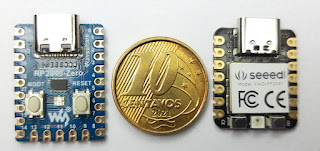Mini Reviews: Waveshare RP2040 Zero and Seeed XIAO RP2040
Two boards with the Raspberi Pi Pico's RP2040 microcontroller. They are similar: small form factor and a USB-C connector. Let's see what is the same and what is different between them.
 |
| The boards beside a Brazilian 10 cents coin |
- RP2040 microcontroller
- 2M byte Flash memory
- Two push buttons (Boot and Reset)
- One RGB LED (WS2812)
Waveshare RP2040 Zero
The RP2040 Zero is slightly longer than the XIAO, but you will have to put them side by side to notice. The small difference is enough to put two more pin at each side. The advantage on accessible pins is even greater: there are five pins in the border opposite the USB connector and 10 pads on the underside(GND + 9 GPIOs).
 |
| "click to enlarge" |
While all pins are in the castellated style, it looks to me impractical to solder the RP2040 zero directly over another board as there are soldered components on the underside. To use the five pins opposite the USB connector in a protoboard you need to solder a 90 degree pin header and use jumpers for the connections. The pads look even more impractical.
The board has a good appearance, but not exceptional. The conversion of the 5V from the USB to the 3.3V needed for the RP2040 and other components is done by an LDO. That's basically a linear converter with an efficiency of about 60%.
Documentation for the RP2040 Zero can be found at https://www.waveshare.com/rp2040-zero.htm.
Seeed XIAO RP2040
SeeedStudio has a long tradition of making microcontroller boards and their latest offerings are quite sophisticated. The XIAO RP2040 looks very professional: a very good looking board with all the components on one side, bellow a metallic shield.
We get only 14 pins at the sides, with about the same functions as the other XIAO boards (the original uses a SAMD21G and there is a third model using a nRF52840). The differences from the original model are less ADC pins and the absence of DAC (both limitations of the RP2040).
 |
| "click to enlarge" |
In the underside there are pads for the RP2040 debug pins (SWD), that is not available on the RP2040 Zero.
The buttons on the XIAO are smaller than the ones in the Zero, making them hard to use. There is a second, RGB LED of the common (not "addressable") kind, connected to three GPIO pins.
The conversion from 5V to 3.3V is done by a switched DC-DC converter, with a better than 90% efficiency.
Documentation for the XIAO RP2040 is at https://wiki.seeedstudio.com/XIAO-RP2040/.
My Considerations
Both boards have about the same price, $1 to $2 above the $4 Pi Pico. The RP2040 zero is available without headers or with soldered headers. The XIAO RP2040 is sold with unsoldered headers. Both companies have other RP2040 boards with more features and higher prices.
If you are looking for the best quality, and your project can be done with the available pins, XIAO RP2040 is your board. On the other hand, the RP2040 XIAO gives a lot of I/O pins (20, not counting the underside pads) in a very compact board.



Comments
Post a Comment